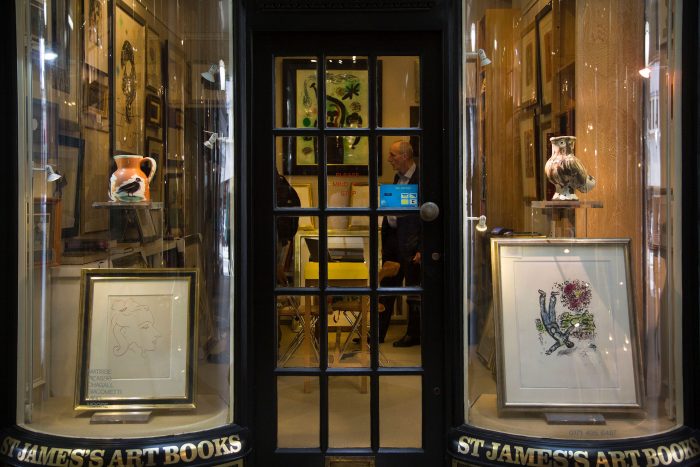
St. James’s Art Books opened in 1993 in Piccadilly Arcade as an art reference bookshop. Over the following years it gradually morphed into an art gallery: it was a natural evolution, started with trading in artist books, containing original graphics; from there it was a small step to framing those graphics, and of course we were helped by our strategic location in the middle of London’s Art Mile. As our situation and solidity progressed, we were able to pursue original works and graphics on the London and global art market, the research task greatly supported by our exhaustive reference library.
Nowadays the gallery deals mainly with modern graphics and with original works of the School of Paris and other artists of the early XXth century. Picasso, Matisse, Miro’ and Chagall are the permanent, dominating presences. We still have plenty of books on our shelves, but they are our own reference works, the treasured tools of our trade. On the other hand, graphics originating from artist books are still an important part
of our offerings.
Artist books, or Livres d’artistes, are a specific and distinct category of works of art, and the ones produced by and for the artists above mentioned in the 1940s, 50s and sixties, are a unique
and highly sophisticated art form.
The formula is based on the text of a classic work of literature, often but not always French, printed in a lavish typeface, interspersed with finely printed illustrations (original graphics, of course) by one of the four great artists living at that time. The edition is often, but again not always, small. An important feature of the artist book was that it gave the artist the chance to produce a cycle, or series: the intention was often narrative but at times is mainly showing variants and permutations of an idea. The assumption of the artist was that the viewer would gently turn the pages, or otherwise progress through the work. This of course leads to the issue of the context and the way these works ought to be viewed, and whether it is questionable to split them up, as indeed we do here. Unsurprisingly, we are enthusiastic about parceling out the works to a multitude of households and locations. The works might not be seen in the context and sequence they were created for, but they are seen indeed, frequently and openly and by many more viewers than they would have done in their boxes. From the point of view of the buyer, the two great advantages of graphics from artist books are the condition of the individual items, invariably pristine as the paper has not seen the light until taken out and framed; and their affordability.
Apart from Livres d’artistes, we permanently stock important signed works by Picasso (etchings, lithographs, linoleum cuts from the Vallauris period, along with a good collection of ceramics), Chagall (lithographs, as we think this is the graphic medium where he really excelled), Miro’, of whom we prefer the etchings from 1970 onward, especially the ones with carborundum, but also lithographs, and Matisse (early etchings in only a few copies, later lithographs, and, if we can find them, the mysterious aquatints of the final years).
More often than not you would find a few Braque with us, as well as British artists such as Moore and Hamilton.
In the original works field, a constant presence here are watercolours by our beloved Mary Fedden, oils and drawings by Andre’ Derain, pastels and little paintings by Andre’ Lhote, and drawings by Steinlen.
Most of our business is conducted from the gallery premises, the majority of our clients having been with us for many years: indeed, the main scope of the present website is to offer a constantly updated access to the changing stock on our walls to our permanent clientele. Of course, we always welcome visits and enquiries from new clients and fellow art-lovers. However, if you do not know us, let me tell you that we are in no hurry to sell you anything: back in 1993 we loved art and art objects with an all-consuming passion, and the trading aspect was just a way for us to be able to purchase and above all, to live in close proximity with these precious artefacts of mankind; to be their curators and carers, for a little while, before passing them on. This has remained unchanged, so many years later. We like to think of ourselves as one of the now very few special, esoteric places in London, where similarly minded people, who do not mind perhaps the paint peeling from the walls and a pre-historic IT system, can go just in order to immerse themselves in a different atmosphere, in a timeless era, created by the objects themselves.
